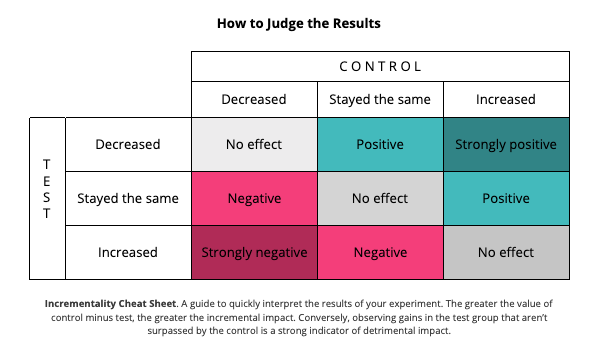If you are not measuring incrementality then you have an incomplete picture on whether your marketing is really making you money. The question is, how do you know if your ads are really impacting customers’ behaviour?
You might be measuring last click performance, but that’s not enough to give you the whole picture, and if you base your decisions on incomplete data, well, enough said…
“Measurement is fabulous. Unless you’re busy measuring what’s easy to measure as opposed to what’s important.”
Seth Godin, author and famously wise chap.
How do you know that the revenue you see in Google Analytics next to ‘Paid Search’ is solely due to the adverts that you’re paying to display, and wouldn’t have been captured anyway by, say, strong organic listings? How can you be certain that your media spend is genuinely making you money?
Incrementality is definitely a made-up word but come on, it’s marketing so that doesn’t really matter. Anyway, 4.5K searches per month on Google, increasing by 180 searches every month in the UK is the only definition we need to justify our use of the term.
KPI-based marketing is obviously great for measuring the as-is value pouring through various marketing funnels but it’s uninformative when it comes to the real value added. Even multi-touch attribution modelling or Google’s latest and most complex marketing attribution product cannot impart the insight necessary to measure incrementality.
The real value of digital marketing is in the incremental sales; the sales that would not have happened without your marketing genius. Running an incrementality experiment is the only way to truly get to the bottom of this. Measuring incremental impact is more than simply suspending your paid media activity for a week and looking at the difference. Running these kinds of tests is tricky business so the point of our whitepaper is to show you how to calculate incremental value in a fair and accurate way.
WHAT DOES ‘INCREMENTALITY’ REALLY MEAN?
In plain English, incrementality is the lift that advertising provides above the native demand. Native demand here refers to the sales that occur without any marketing influence. The difference between native demand and ad-driven sales represents incremental lift – the increase in sales that is truly attributable to paid media.
It is the north star of marketing measurement. By doing it effectively you can begin to quantify the impact of ads on your business and honestly claim responsibility for the results of your work.
HOW TO MEASURE INCREMENTALITY
Don’t worry, you won’t need to slash your profits in half while you run a test. Our incrementality whitepaper explains how to select small subsets of your total audience to compare against each other, and then apply these findings across the board.
| WHAT IS AN INCREMENTAL LIFT TEST? Experiments relying on treatment and control groups are the scientific gold standard in determining what works and what should play an important role in an advertiser’s attribution strategy. Your incrementality experiment should have two main features: – A well-defined test group that will no longer be served ads. – A carefully matched control group with a level of spending consistent with the past three months at least. |
In essence, you’re looking to judge the difference in performance between your audience that had ads taken away (treatment) and your audience that had ads served as usual (control).
How to Judge the Results

WHAT TO DO WITH THE RESULTS
Your final incremental value figure shows you how much revenue was driven by advertising for the audiences that you selected for the experiment. What happens when you scale that figure across your entire market? Then across an entire financial year?
Numbers are great (I’m a data scientist, I would know) but they make a lot more sense in context. Usually you would run the experiment over a period of only several months. Although, given unlimited resources I would opt for an always-on experiment to constantly monitor incrementality. Once you know your incremental uplift percentage, you can apply it in different scenarios. How much incremental revenue can you attribute to advertising over the course of an entire year, for example?
In fact, we recently ran an experiment just like this for one of our clients.
Our goal was to measure the incremental impact of paid media advertising in particular across Google Ads, Bing Ads and Facebook Ads. We were able to prove that the incremental value of paid media was actually higher than the overall share of revenue attributed to those channels in Google Analytics. This means that the revenue generated by paid media as we reported it was an underestimation of how much value it was really delivering.
We interpret this as evidence of cross-channel attribution – the halo effect of paid media advertising, and it’s probably what you’ll see as well. Proof that the value of advertising is seen in other channels like Organic Search, Email and even offline purchases. Furthermore, our results allude to the power of paid advertising in generating brand awareness via generic keywords which can be swept up by other channels.

BEFORE YOU GO
As a data scientist I know how dangerous proclaiming a causal impact between two variables is. There are a lot of different and impossible-to-measure variables in play at any time. Controlling for all of these factors is just not plausible.
However this is about actionable insight – it’s about getting as close to the truth as possible. We can be mindful of external circumstances and have a solid grasp of our domains – elections, sales, climaxes of reality TV shows. It’s an iterative process; test what works, learn from what doesn’t.
If you want to measure the real impact of something, this really is the only way you can do it. Here is a complete guide to correctly selecting your control and testing groups and how to run (and extend) your experiments to cover any marketing channel you want to measure.
If you would like to speak to someone at Found regarding running an incrementality test for your business, then get in touch.


